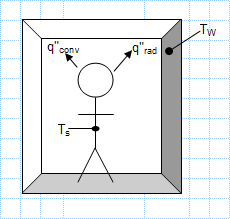Surface temperature convection coefficient and emissivity of a person in the room.xls

Description
KNOWN: Air and wall temperatures of a room. Surface temperature, convection coefficient and emissivity of a person in the room.
FIND: Basis for difference in comfort level between summer and winter
ASSUMPTIONS: 1) Person may be approximated as a small object in a large enclosure
ANALYSIS: Thermal discomfort is linked to heat loss from the human body, a chilled feeling is associated with excessive heat loss. Because the temperature of the room air is fixed the different summer and winter levels cannot be attributed to convection heat transfer from the body.
Calculation Reference
Fundamentals of Heat and Mass Transfer - Frank P. Incropera
In the given scenario, where the air and wall temperatures of a room, as well as the surface temperature, convection coefficient, and emissivity of a person, are known, the difference in comfort level between summer and winter cannot be solely attributed to convection heat transfer from the body. Here's an analysis considering the factors involved:
-
Convection heat transfer: Convection heat transfer from the body to the surrounding air depends on the temperature difference between the body surface and the air, as well as the convection coefficient. However, as stated, the temperature of the room air is fixed, meaning the difference in convection heat transfer between summer and winter is not significant.
-
Radiation heat transfer: Radiation heat transfer between the body and the surrounding surfaces, including walls, can have an impact on comfort level. The radiation exchange is influenced by the difference in surface temperatures and the emissivity of the person and the surrounding surfaces. During winter, when the room air temperature is colder, the person may experience a higher heat loss through radiation to the colder walls, resulting in a perceived discomfort. In summer, the walls may be closer in temperature to the person's body, reducing the radiation heat loss and improving comfort.
-
Clothing and insulation: The clothing worn by the person can play a significant role in thermal comfort. In winter, people tend to wear more clothing layers, providing insulation and reducing heat loss from the body. In contrast, in summer, lighter clothing allows for better heat dissipation and improved comfort.
-
Metabolic heat production: The body's metabolic rate, which generates heat, can vary depending on the activities being performed. In winter, the body may naturally produce more heat to maintain body temperature, leading to a higher perceived comfort level. In summer, the body may experience less metabolic heat production, contributing to a more comfortable feeling.
It's important to note that thermal comfort is a complex and subjective phenomenon influenced by various factors, including personal preferences, humidity levels, air movement, and individual differences in thermal sensitivity. The analysis provided here highlights some of the potential factors contributing to the difference in comfort level between summer and winter but may not capture all the intricacies of the situation.
Calculation Preview
Full download access to any calculation is available to users with a paid or awarded subscription (XLC Pro).
Subscriptions are free to contributors to the site, alternatively they can be purchased.
Click here for information on subscriptions.
